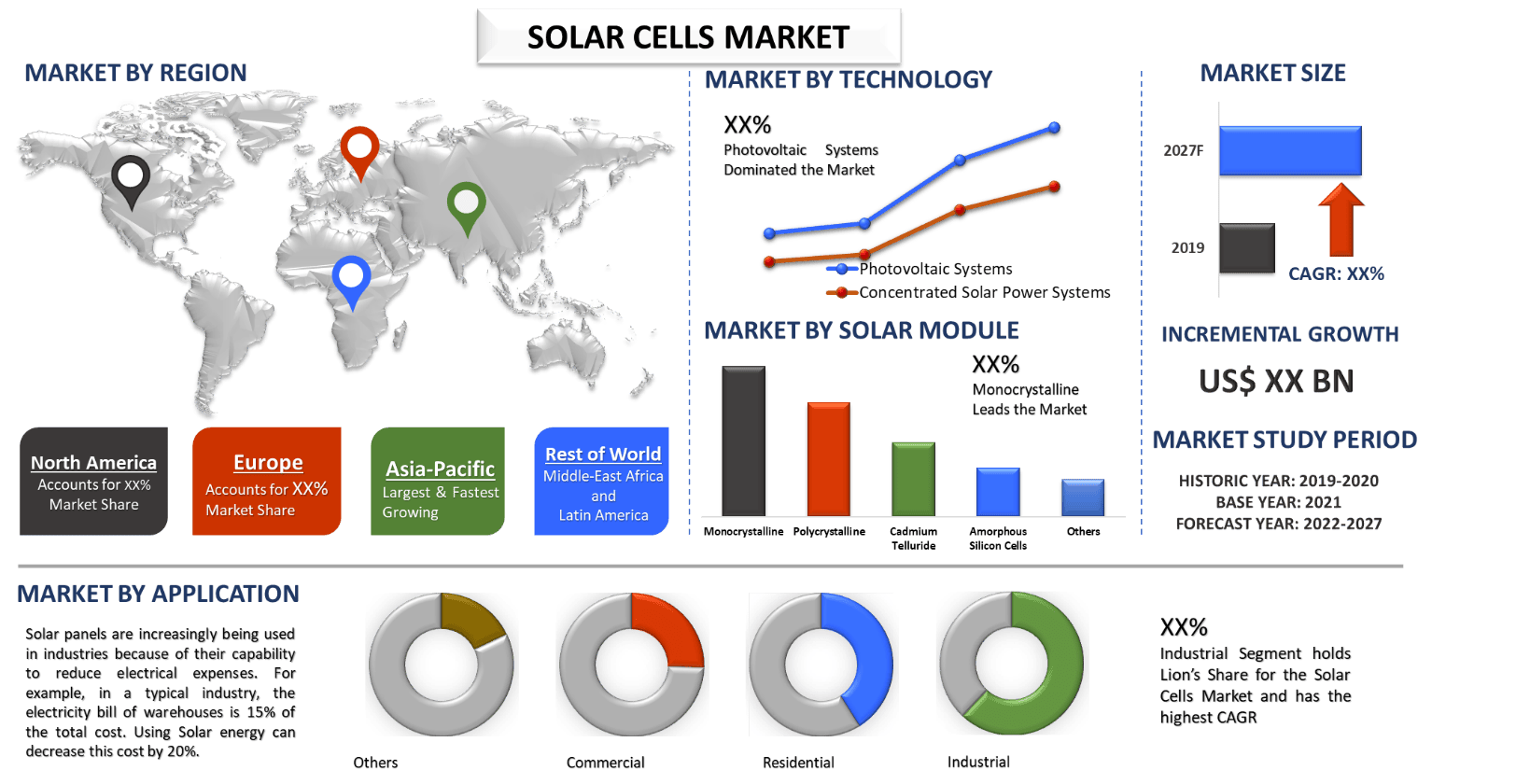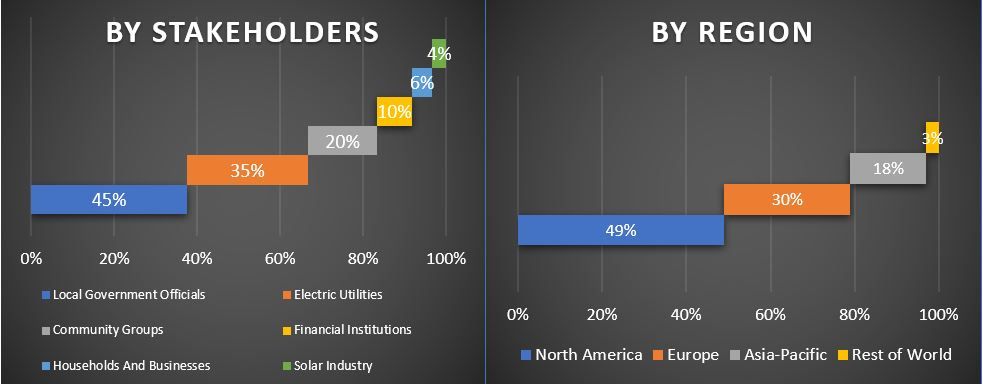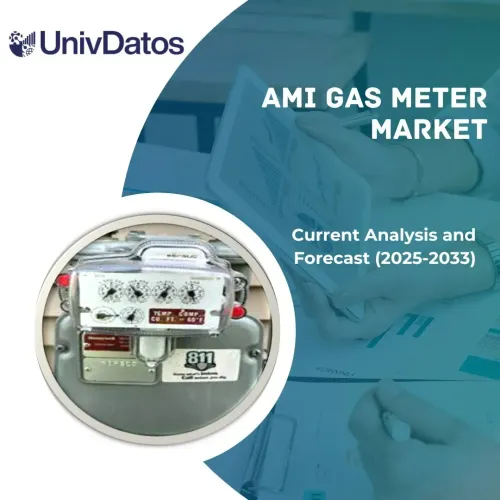- Home
- About Us
- Industry
- Services
- Reading
- Contact Us
Solar Cells Market: Current Analysis and Forecast (2021-2027)
Emphasis on Technology (Photovoltaic Systems, Concentrated Solar Power Systems); Solar Modules (Monocrystalline, Polycrystalline, Cadmium Telluride, Amorphous Silicon Cells, Others); Applications (Residential, Commercial, Industrial, Others); End-User (Electricity Generation, Lighting, Heating, Charging); Region and Country

Solar Cells Market was valued at ~US$ 65 billion in 2020 and is expected to grow at a CAGR of ~10% over the forecast period (2021-2027). Solar panels collect clean renewable energy from sunlight and convert that into electricity which is used to power electrical loads. Solar panels are made from several combined solar cells with layers of silicon, phosphorus (negative charge) and boron (positive charge). Solar panels initiate the electric current by absorbing photons which knocks of electrons front their atomic orbits and form an electric field which then pull these free electrons into a directional current. This entire process is known as the photovoltaic effect. Solar panels placed on a house roof transfer all the electricity into the main power grid which can be stored and used at night. In a well-balanced grid, power is generated by solar panels during the day which is stored and then can be utilized at night. In some countries, additional power generated by solar panel owners at home can sell it to the electricity produces.
The popularity of solar panels is increasing as they have become affordable. Cost of Solar PVs have decreased from US$ 0.37/kWh in 2010 to US$ 0.085/kWh in 2018 and is further expected to decrease to US$ 0.05-0.01/kWh by 2050. In addition to this, the changing government policies, and awareness about the benefits of sustainable energy is also influencing the market growth. If 8,500 GW of solar energy can be produced, this will generate more than 25% of the electricity requirement by 2050 and mitigate 4.9 Gt of CO2 emissions. Furthermore, with the increasing demand for electricity and low maintenance cost of solar panels, they are cheaper in the long run which makes them a good investment in private households. In the long run one can save up to US$ 43,735 on electricity by using solar panels in 20 years. Apart from this, the efficiency of solar panels has also significantly increased over time. Multi-Crystalline PV reached 17% efficiency and mono-crystalline PV have reached 18% efficiency since 2018. All these developments are boosting the growth in the solar cells market.
Electricity Generation Costs from Various Sources in Europe (US$)
Abengoa Se, Acciona S.A., Canadian Solar, Inc., Esolar, Inc., United Renewable Energy Co. Ltd., Sunpower Corporation, Kaneka Corporation, Tata Power Solar Systems Ltd., Wuxi Suntech Power Co., Ltd., and Brightsource Energy, Inc. are some of the prominent players operating in the Solar Cells market. Several M&As along with partnerships have been undertaken by these players to facilitate customers with hi-tech and innovative products/technologies.
Insights Presented in the Report
“Amongst Technology, Photovoltaic segment holds the major share”
Based on Technology, the Solar Cells market is segmented into Photovoltaic Systems and Concentrated Solar Power Systems. Amongst technology, the Photovoltaic Systems segment of the Solar Cells market was valued at US$ XX billion in 2020 and is likely to reach US$ XX billion by 2027 and is growing at a CAGR of XX% from 2021-2027. Photovoltaic (PV) Systems are composed of one or more solar panels which are combined with an inverter and some electrical and mechanical hardware which uses energy from the sun to generate electricity. The global solar photovoltaic capacity has grown from 5 GW in 2005 to around 509.3 GW in 2018.
“Amongst Solar Modules, Monocrystalline Segment holds the major share”
Based on Solar Module, the Solar Cells market is segmented into Monocrystalline, Polycrystalline, Cadmium Telluride, Amorphous Silicon Cells, and Others. Amongst Solar Module, Monocrystalline segment accounted for a market valuation of US$ XX billion in 2020 and is expected to reach US$ XX billion by the year 2027, at a CAGR of XX% over the analyzed period. Monocrystalline panels are single, flat black color panels which makes them popular among homeowners because of their better design and look. Monocrystalline panels traditionally contain from 60 to 72 solar cells depending on the size of the panels.
“Amongst Application, Industrial Segment holds the major share”
Based on Application, the Solar Cells market is segmented into Residential, Commercial, Industrial, and Others. The industrial segment generated revenue of US$ XX billion in 2020 and is expected to grow at a CAGR of XX% during the forecast period to reach a market valuation of US$ XX billion by 2027F. Solar panels are increasingly being used in industries because of their capability to reduce electrical expenses. For example, in a typical industry, the electricity bill of warehouses is 15% of the total cost. Using Solar energy can decrease this cost by 20%.
“Amongst End-User, Electricity Generation Segment holds the major share”
Based on End-User, the Solar Cells market is segmented into Electricity Generation, Lighting, Heating, and Charging. Amongst end-user, the Electricity Generation segment of the Solar Cells market was valued at US$ XX billion in 2020 and is likely to reach US$ XX billion by 2027 and is growing at a CAGR of XX% from 2021-2027. A single photovoltaic cell generates about 2 watts of electricity. Hundreds of solar cells can be connected to form solar panels which can then generates thousands of kilowatts of electric power. Most present-day photovoltaic cells have the efficiency of about 15-20%.
“Asia Pacific represents one of the largest markets of Solar Cells market”
For a better understanding of the market dynamics of the Solar Cells market, a detailed analysis was conducted for different regions across the globe including North America (the U.S, Canada, and the Rest of North America), Europe (Germany, France, Italy, United Kingdom, Spain, and Rest of Europe), Asia-Pacific (China, Japan, India, Australia, and Rest of APAC) and Rest of the World. Asia Pacific dominated the market and grabbed around XX% market share owing to increasing demand for electricity in the region.
Reasons to buy this report:
- The study includes market sizing and forecasting analysis validated by authenticated key industry experts
- The report presents a quick review of overall industry performance at one glance
- The report covers an in-depth analysis of prominent industry peers with a primary focus on key business financials, product portfolio, expansion strategies, and recent developments
- Detailed examination of drivers, restraints, key trends, and opportunities prevailing in the industry
- The study comprehensively covers the market across different segments
- Deep dive regional level analysis of the industry
Customization Options:
Solar Cells market can further be customized as per the requirement or any other market segment. Besides this, UMI understands that you may have your own business needs, hence feel free to connect with us to get a report that completely suits your requirements.
Table of Content
Analyzing the historical market, estimation of the current market, and forecasting the future market of the Solar Cells market were the three major steps undertaken to create and analyze the adoption of Solar Cells in major regions globally. Exhaustive secondary research was conducted to collect the historical market numbers and estimate the current market size. Secondly, to validate these insights, numerous findings and assumptions were taken into consideration. Moreover, exhaustive primary interviews were also conducted, with industry experts across the value chain of the Solar Cells market. Post assumption and validation of market numbers through primary interviews, we employed a top-down/bottom-up approach to forecasting the complete market size. Thereafter, market breakdown and data triangulation methods were adopted to estimate and analyze the market size of segments and sub-segments the industry pertains to. Detailed methodology is explained below:
Analysis of Historical Market Size
Step 1: In-Depth Study of Secondary Sources:
Detail secondary study was conducted to obtain the historical market size of the Solar Cells through company internal sources such as annual report & financial statements, performance presentations, press releases, etc., and external sources including journals, news & articles, government publications, competitor publications, sector reports, third-party database, and other credible publications.
Step 2: Market Segmentation:
After obtaining the historical market size of the Solar Cells market, we conducted a detailed secondary analysis to gather historical market insights and share for different segments & sub-segments for major regions. Major segments included in the report as technology, solar module, application, and end-user. Further country-level analyses were conducted to evaluate the overall adoption of renewable energy in that region.
Step 3: Factor Analysis:
After acquiring the historical market size of different segments and sub-segments, we conducted a detailed factor analysis to estimate the current market size of Solar Cells. Further, we conducted factor analysis using dependent and independent variables such as increasing efficiency of solar cells and its lowering maintenance cost. A thorough analysis was conducted for demand and supply-side scenarios considering top partnerships, merger and acquisition, business expansion, and product launches in the Solar Cells sector across the globe.
Current Market Size Estimate & Forecast
Current Market Sizing: Based on actionable insights from the above 3 steps, we arrived at the current market size, key players in the Solar Cells market, and market shares of the segments. All the required percentage shares split, and market breakdowns were determined using the above-mentioned secondary approach and were verified through primary interviews.
Estimation & Forecasting: For market estimation and forecast, weights were assigned to different factors including drivers & trends, restraints, and opportunities available for the stakeholders. After analyzing these factors, relevant forecasting techniques i.e., top-down/bottom-up approach was applied to arrive at the market forecast about 2027 for different segments and subsegments across the major markets globally. The research methodology adopted to estimate the market size encompasses:
- The industry’s market size, in terms of value (US$) and the adoption rate of Solar Cells across the major markets domestically
- All percentage shares, splits, and breakdowns of market segments and sub-segments
- Key players in the Solar Cells market in terms of products offered. Also, the growth strategies adopted by these players to compete in the fast-growing market
Market Size and Share Validation
Primary Research: In-depth interviews were conducted with the Key Opinion Leaders (KOLs) including Top Level Executives (CXO/VPs, Sales Head, Marketing Head, Operational Head, and Regional Head, Country Head, etc.) across major regions. Primary research findings were then summarized, and statistical analysis was performed to prove the stated hypothesis. Inputs from primary research were consolidated with secondary findings, hence turning information into actionable insights.
Split of Primary Participants in Different Regions
Market Engineering
Data triangulation technique was employed to complete the overall market estimation and to arrive at precise statistical numbers of each segment and sub-segment of the Solar Cells market. Data was split into several segments & sub-segments post studying various parameters and trends in the areas of type and their type of the Solar Cells market.
The main objective of the Solar Cells Market Study
The current & future market trends of Solar Cells were pinpointed in the study. Investors can gain strategic insights to base their discretion for investments from the qualitative and quantitative analysis performed in the study. Current and future market trends were determined the overall attractiveness of the market at a regional level, providing a platform for the industrial participant to exploit the untapped market to benefit as a first-mover advantage. Other quantitative goals of the studies include:
- Analyze the current and forecast market size of Solar Cells in terms of value (US$). Also, analyze the current and forecast market size of different segments and sub-segments
- Segments in the study include areas of type and their subtypes
- Define and analysis of the regulatory framework for the Solar Cells industry
- Analyze the value chain involved with the presence of various intermediaries, along with analyzing customer and competitor behaviors of the industry
- Analyze the current and forecast market size of the Solar Cells market for the major region
- Major regions studied in the report include North America (the U.S, Canada, and Rest of North America), Europe (Germany, United Kingdom, France, Spain, Italy, and Rest of Europe), Asia-Pacific (China, Japan, India, Australia, and Others), and the Rest of the World
- Company profiles of the Solar Cells market and the growth strategies adopted by the market players to sustain in the fast-growing market
- Deep dive regional level analysis of the industry
Related Reports
Customers who bought this item also bought












